tire pressure CHEVROLET SUBURBAN 1997 Owners Manual
[x] Cancel search | Manufacturer: CHEVROLET, Model Year: 1997, Model line: SUBURBAN, Model: CHEVROLET SUBURBAN 1997Pages: 433, PDF Size: 21.49 MB
Page 187 of 433
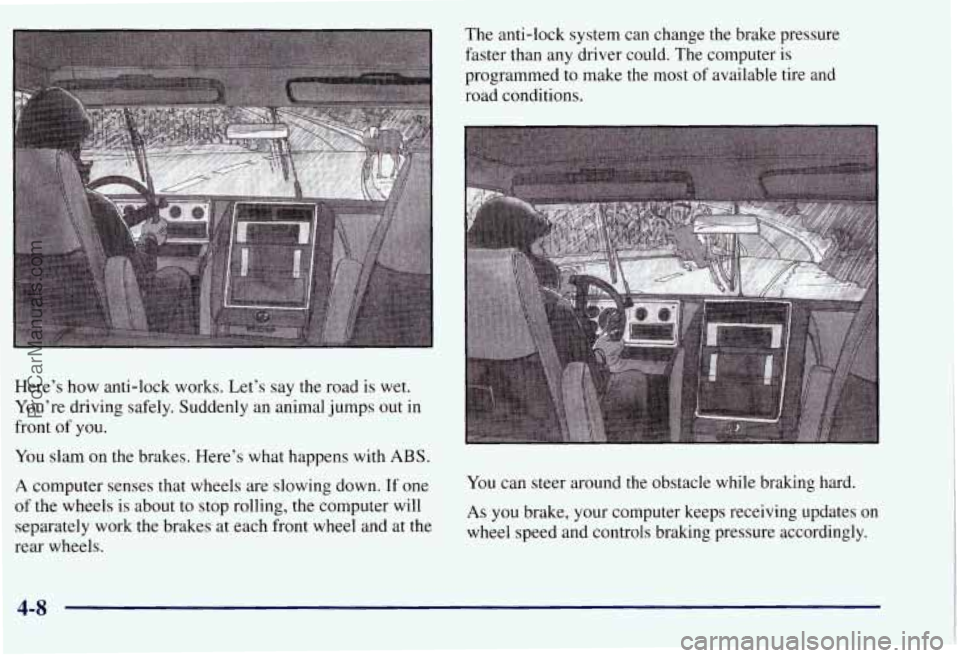
Here’s how anti-lock works. Let’s say the road is wet.
You’re driving safely. Suddenly an animal jumps out in
front
of you.
You slam on the brakes. Here’s what happens with ABS.
A computer senses that wheels are slowing down. If one
of the wheels is about to stop rolling, the computer will
separately work the brakes at each front wheel and at the
rear wheels. The
anti-lock system can change the brake pressure
faster than any driver could. The computer is
programmed to make the most of available tire and
road conditions.
You can steer around the obstacle while braking hard. As you brake, your computer keeps receiving updates on
wheel speed and controls braking pressure accordingly.
4-8
ProCarManuals.com
Page 205 of 433
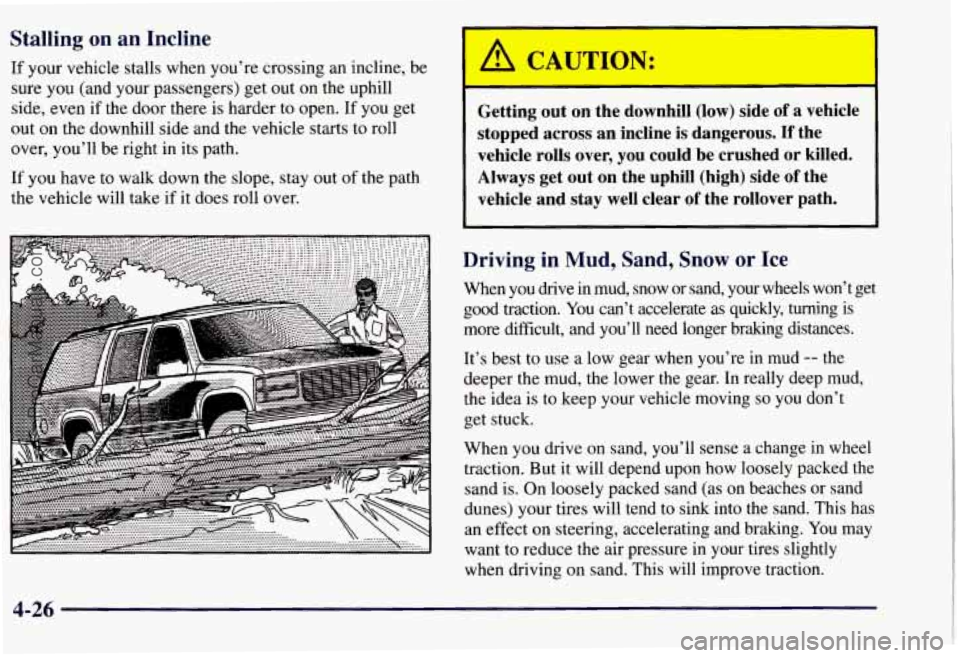
Stalling on an Incline
If your vehicle stalls when you’re crossing an incline, be
sure you (and your passengers) get out on the uphill
side, even if the door there is harder to open. If you get
out
on the downhill side and the vehicle starts to roll
over, you’ll be right in its path.
If you have to walk down the slope, stay out of the path
the vehicle will take
if it does roll over.
Getting out on the downhill (low) side of a vehicle
stopped across an incline
is dangerous. If the
vehicle rolls over, you could be crushed or killed.
Always get out on the uphill (high) side
of the
vehicle and stay well clear
of the rollover path.
Driving in Mud, Sand, Snow or Ice
When you drive in mud, snow or sand, your wheels won’t get
good traction. You can’t accelerate as quickly, turning is
more difficult, and you’ll need longer braking distances.
It’s best to use a low gear when you’re in mud
-- the
deeper the mud, the lower the gear. In really deep mud,
the idea
is to keep your vehicle moving so you don’t
get stuck.
When you drive on sand, you’ll sense a change in wheel
traction. But it will depend upon how loosely packed the
sand is. On loosely packed sand (as on beaches or sand
dunes) your tires will tend to sink into the sand. This has
an effect
on steering, accelerating and braking. You may
want
to reduce the air pressure in your tires slightly
when driving on sand. This will improve traction.
4-26
ProCarManuals.com
Page 210 of 433
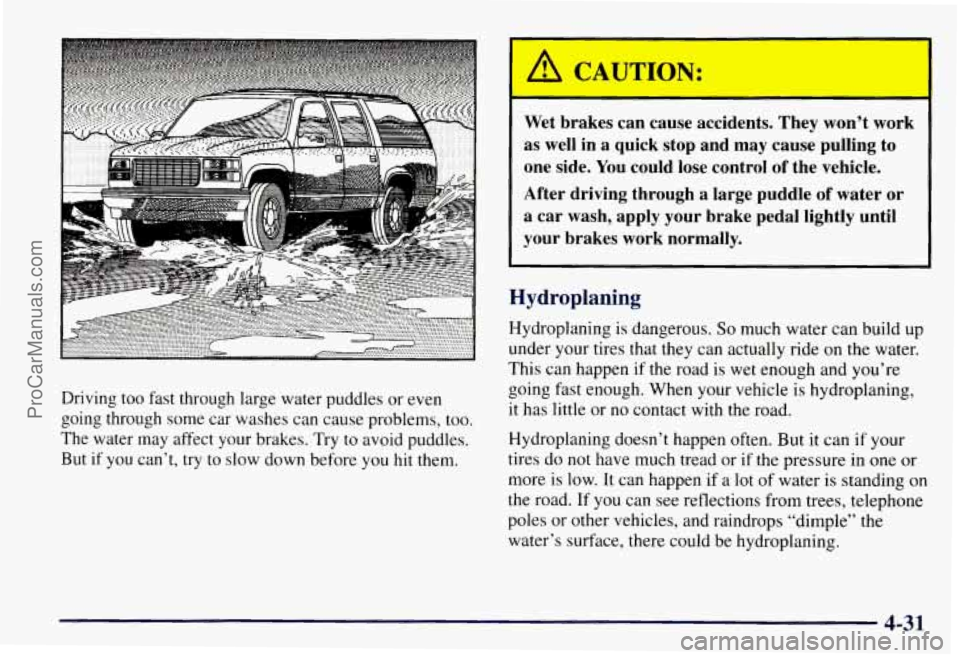
I
Driving too fast through large water puddles or even
going through some car washes can cause problems, too.
The water may affect your brakes. Try to avoid puddles.
But if you can’t, try to slow down before you hit them.
Wet brakes can cause accidents. They won’t work
as well in a quick stop and may cause pulling to
one side.
You could lose control of the vehicle.
After driving through a large puddle of water or a car wash, apply your brake pedal lightly until
your brakes work normally.
Hydroplaning
Hydroplaning is dangerous. So much water can build up
under your tires that they can actually ride
on the water.
This can happen if the road is wet enough and you’re
going fast enough. When your vehicle is hydroplaning,
it has little or no contact with the road.
Hydroplaning doesn’t happen often. But it can if your
tires do not have much tread or if the pressure in one or
more is low. It can happen if a lot of water is standing
on
the road. If you can see reflections from trees, telephone
poles
or other vehicles, and raindrops “dimple” the
water’s surface, there could be hydroplaning.
4-31
ProCarManuals.com
Page 214 of 433
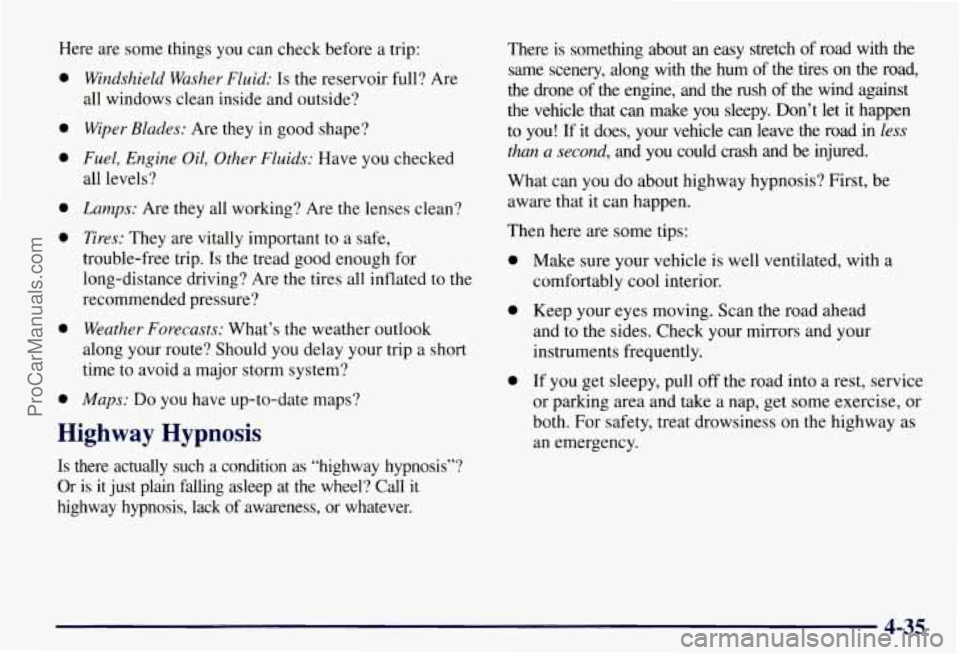
Here are some things you can check before a trip:
0
0
0
0
0
0
0
Windshield Washer Fluid: Is the reservoir full? Are
all windows clean inside and outside?
Wiper Blades: Are they in good shape?
Fuel, Engine Oil, Other Fluids: Have you checked
all levels?
Lamps: Are they all working? Are the lenses clean?
Tires: They are vitally important to a safe,
trouble-free trip.
Is the tread good enough for
long-distance driving? Are the tires all inflated to the
recommended pressure?
Weather Forecasts: What’s the weather outlook
along your route? Should you delay your trip a short
time to avoid a major storm system?
Maps: Do you have up-to-date maps?
Highway Hypnosis
Is there actually such a condition as “highway hypnosis”?
Or is it just plain falling asleep at the wheel? Call it
highway hypnosis, lack of awareness, or whatever. There is something about an easy stretch
of road with the
same scenery, along with the hum of the tires
on the road,
the drone of the engine, and the rush of
the wind against
the vehicle that can make you sleepy. Don’t let it happen
to you! If it does, your vehicle can leave the road in
less
than a second,
and you could crash and be injured.
What can you do about highway hypnosis? First, be
aware that it can happen.
Then here are some tips:
0
0
0
Make sure your vehicle is well ventilated, with a
comfortably cool interior.
Keep your eyes moving, Scan the road ahead
and
to the sides. Check your mirrors and your
instruments frequently.
If
you get sleepy, pull off the road into a rest, service
or parking area and take
a nap, get some exercise, or
both. For safety, treat drowsiness on the highway as
an emergency.
4-35
ProCarManuals.com
Page 221 of 433
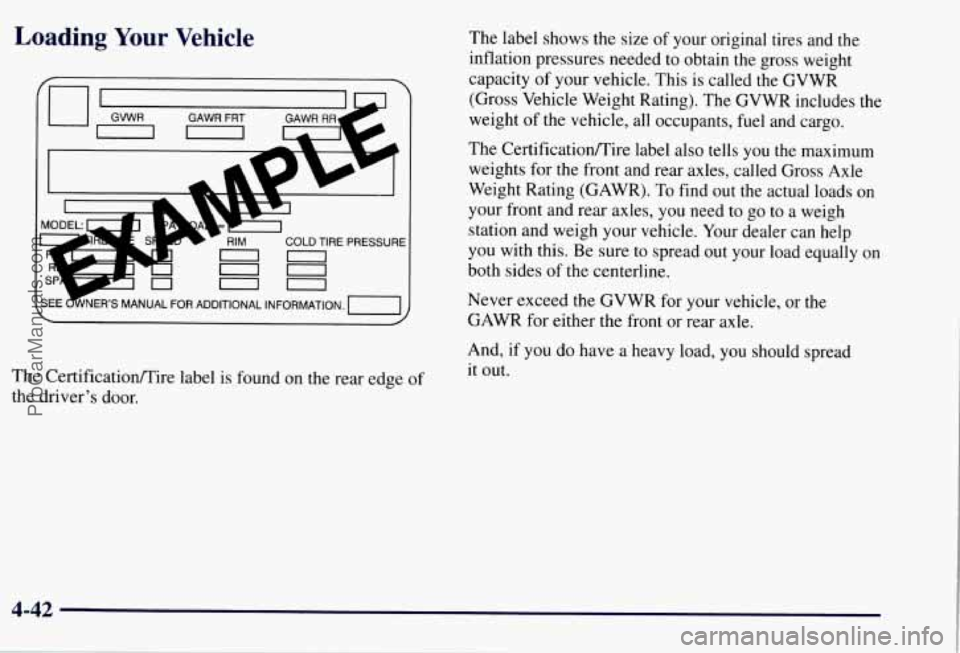
Loading Your Vehicle
The Certificatiomire label is found on the rear edge of
the driver's door. The
label shows the size of your original tires and the
inflation pressures needed to obtain the gross weight
capacity of your vehicle. This is called the GVWR
(Gross Vehicle Weight Rating). The GVWR includes the
weight
of the vehicle, all occupants, fuel and cargo.
The Certificatioflire label also tells you
the maximum
weights for the front and rear axles, called Gross Axle
Weight Rating (GAWR). To find out the actual loads on
your front and rear axles, you need to go to a weigh
station and weigh your vehicle. Your dealer can help
you with this. Be sure to spread out your load equally on
both sides
of the centerline.
Never exceed the GVWR for your vehicle, or the
GAWR for either the front or rear axle.
And, if
you do have a heavy load, you should spread
it out.
4-42
ProCarManuals.com
Page 280 of 433
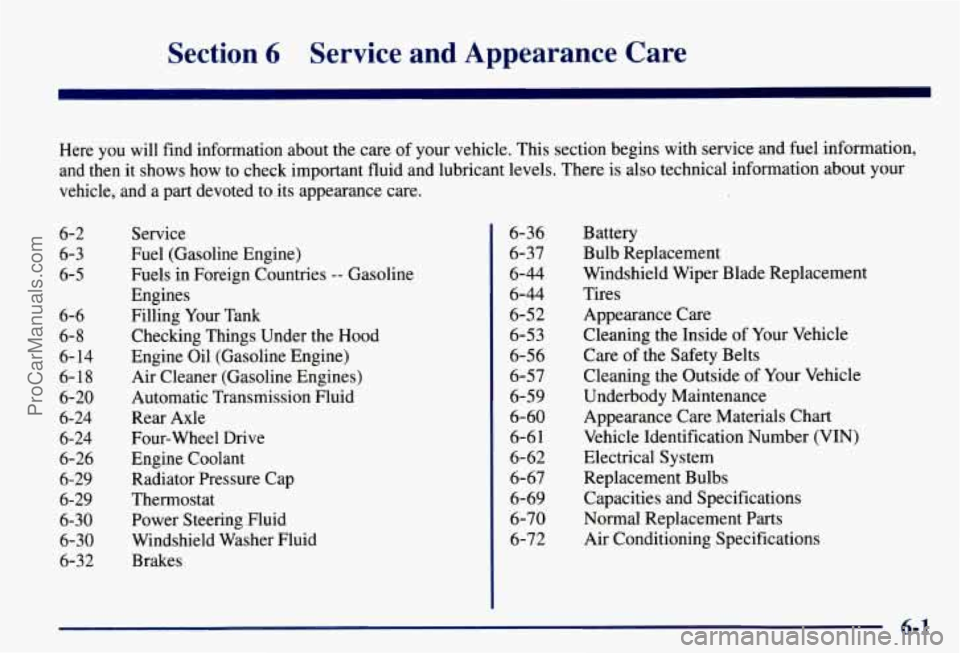
Section 6 Service and Appearance Care
Here you will find information about the care of your vehicle. This section begins with service and fuel information,
and then it shows how to check important fluid and lubricant levels. There is also technical information about your
vehicle, and a part devoted to its appearance care.
6-2
6-3
6-5
6-6
6-8
6- 14
6-18
6-20
6-24 6-24
6-26
6-29
6-29
6-30
6-30
6-32 Service
Fuel (Gasoline Engine)
Fuels
in Foreign Countries -- Gasoline
Engines
Filling Your Tank
Checking Things Under the Hood
Engine Oil (Gasoline Engine)
Air Cleaner (Gasoline Engines)
Automatic Transmission Fluid
Rear Axle
Four-wheel Drive
Engine Coolant
Radiator Pressure Cap
Thermostat
Power Steering Fluid
Windshield Washer Fluid
Brakes
6-36
6-37
6-44
6-44
6-52
6-53
6-56
6-57
6-59
6-60 6-6 1
6-62
6-67
6-69
6-70
6-72 Battery
Bulb Replacement
Windshield Wiper Blade Replacement
Tires Appearance Care
Cleaning the Inside
of Your Vehicle
Care of the Safety Belts
Cleaning the Outside of Your Vehicle
Underbody Maintenance
Appearance Care Materials Chart
Vehicle Identification Number (VIN)
Electrical System
Replacement Bulbs
Capacities and Specifications
Normal Replacement Parts
Air Conditioning Specifications
6-1
ProCarManuals.com
Page 324 of 433
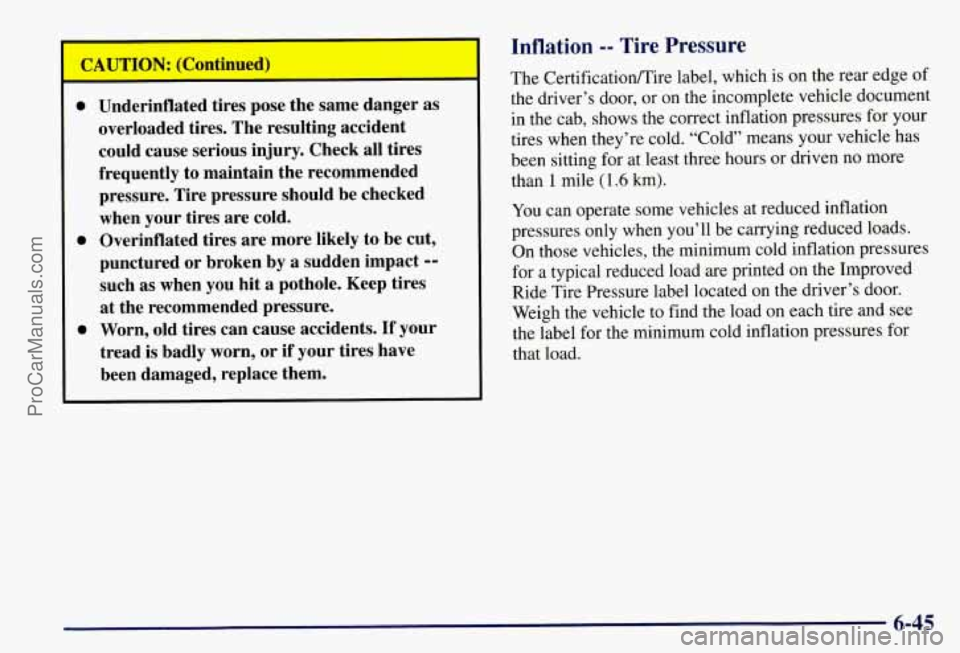
CAUTION: (Co
0 Underinflated tires pose the same danger as
overloaded tires. The resulting accident
could cause serious injury. Check all tires
frequently to maintain the recommended
pressure. Tire pressure should be checked
when your tires are cold.
0 Overinflated tires are more likely to be cut,
punctured or broken by a sudden impact
--
such as when you hit a pothole. Keep tires
at the recommended pressure.
0 Worn, old tires can cause accidents. If your
tread is badly worn, or if your tires have
been damaged, replace them.
Inflation -- Tire Pressure
The Certificatioflire label, which is on the rear edge of
the driver’s door, or on the incomplete vehicle document
in the cab, shows the correct inflation pressures for your tires when they’re cold. “Cold” means your vehicle has
been sitting for at least three hours or driven no more
than
1 mile (1.6 km).
You can operate some vehicles at reduced inflation
pressures only when you’ll be carrying reduced loads.
On those vehicles, the minimum cold inflation pressures
for a typical reduced load are printed on the Improved
Ride Tire Pressure label located
on the driver’s door.
Weigh the vehicle to find the load on each tire and see
the label for the minimum cold inflation pressures for
that load.
6-45
ProCarManuals.com
Page 325 of 433
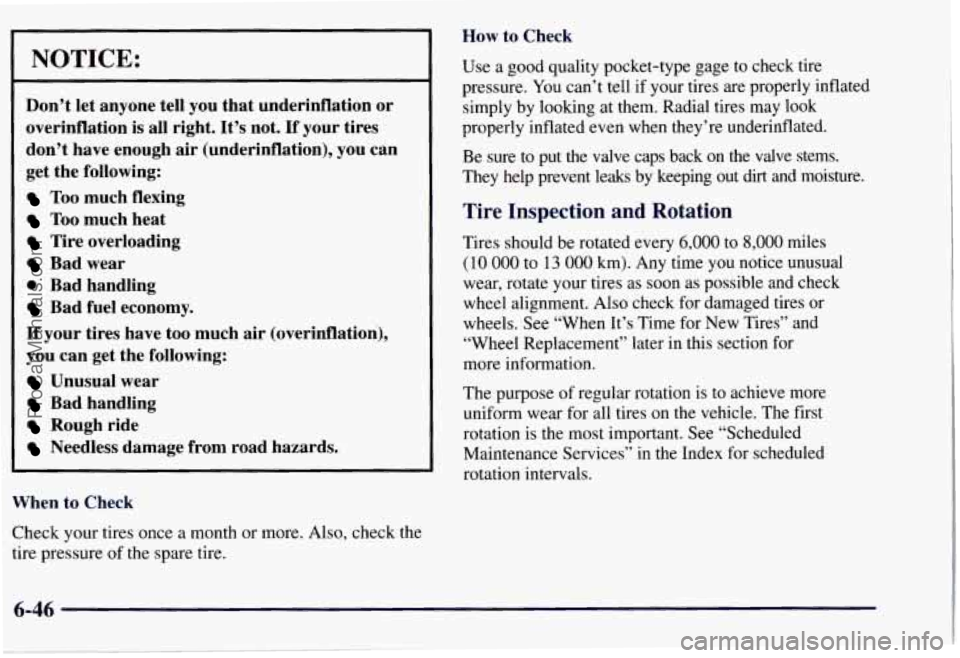
NOTICE:
Don’t let anyone tell you that underinflation or
overinflation is all right. It’s not.
If your tires
don’t have enough air (underinflation), you can
get the following:
Too much flexing
Too much heat
Tire overloading
Bad wear
0 Bad handling
Bad fuel economy.
If your tires have too much air (overinflation),
you can get the following:
Unusual wear
Bad handling
Rough ride
Needless damage from road hazards.
When to Check
Check your tires once a month or more. Also, check the
tire pressure of the spare tire.
How to Check
Use a good quality pocket-type gage to check tire
pressure. You can’t tell
if your tires are properly inflated
simply by looking at them. Radial tires may look
properly inflated even when they’re underinflated.
Be sure to put the valve caps back on the valve stems.
They help prevent
leaks by keeping out dirt and moisture.
Tire Inspection and Rotation
Tires should be rotated every 6,000 to 8,000 miles
(10 000 to 13 000 km). Any time you notice unusual
wear, rotate your tires as soon as possible and check
wheel alignment. Also check for damaged tires or
wheels. See “When It’s Time for New Tires” and
“Wheel Replacement” later in this section for
more information.
The purpose
of regular rotation is to achieve more
uniform wear for all tires on the vehicle. The first
rotation is the most important. See “Scheduled
Maintenance Services” in the Index for scheduled
rotation intervals.
ProCarManuals.com
Page 326 of 433
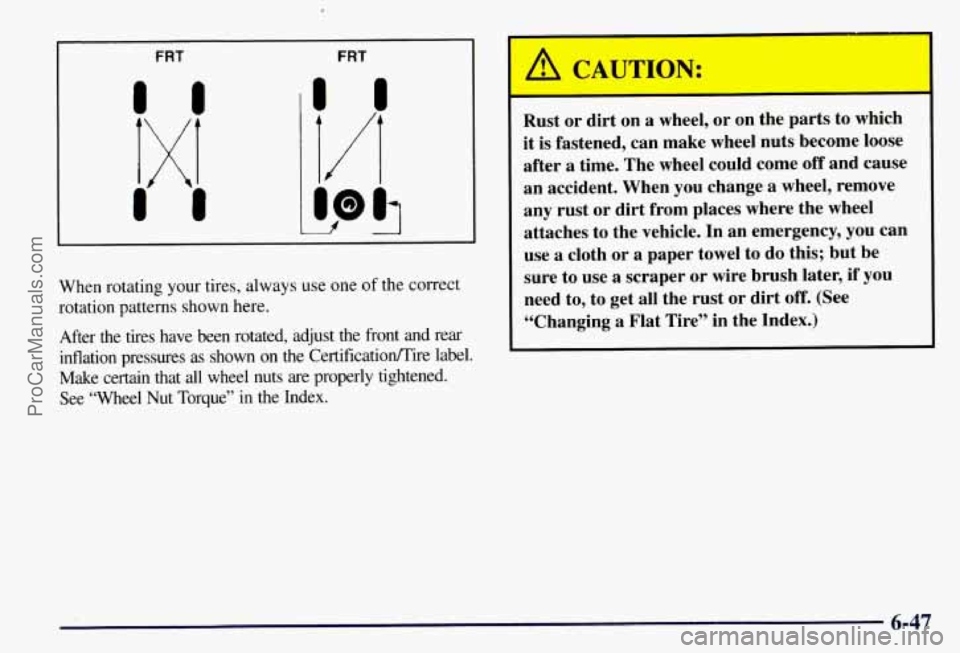
FRT
f DO5
When rotating your tires, always use one of the correct
rotation patterns shown here.
After the tires have been rotated, adjust the front and rear
inflation pressures as shown
on the Certificatioflire label.
Make certain that
all wheel nuts are properly tightened.
See “Wheel Nut Torque” in the Index.
I A C. UTION:
Rust or dirt on a wheel, or on the parts to which
it is fastened, can make wheel nuts become loose
after
a time. The wheel could come off and cause
an accident. When you change a wheel, remove
any rust
or dirt from places where the wheel
attaches to the vehicle. In an emergency, you can
use a cloth or a paper towel to do this; but be
sure to use a scraper or wire brush later,
if you
need to, to get all the rust or dirt
off. (See
“Changing a Flat Tire” in the Index.)
6-47
ProCarManuals.com
Page 348 of 433
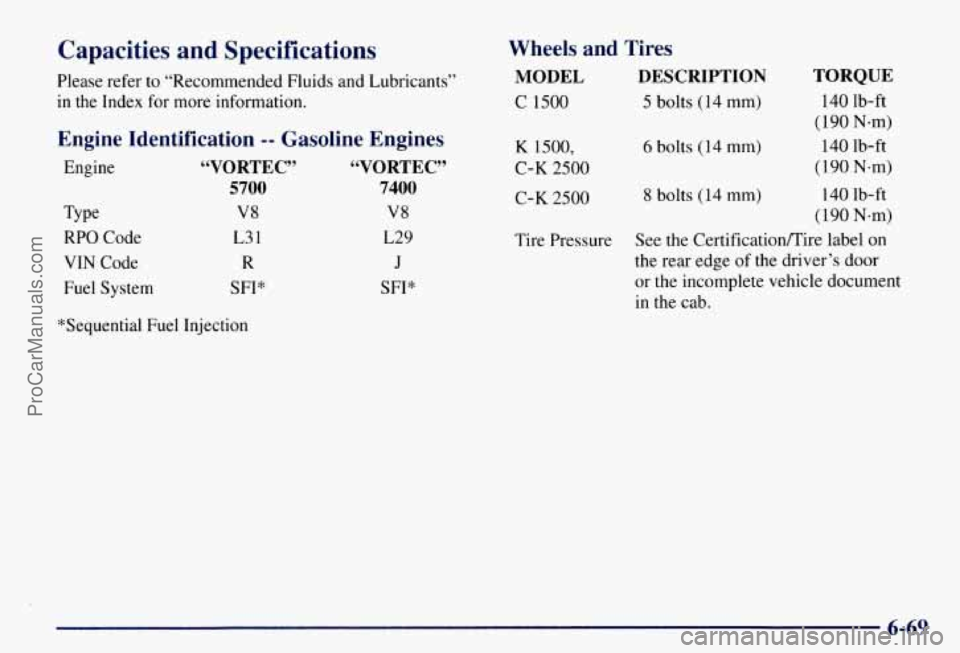
Capacities and Specifications
Please refer to “Recommended Fluids and Lubricants”
in the Index for more information.
Type
RPO Code
VIN Code
Fuel System
Engine Identification -- Gasoline Engines
Engine “VORTEC” “VORTEC”
5700 7400
V8 V8
L3 1 L29
R J
SFI* SFI*
*Sequential Fuel Injection
Wheels and Tires
MODEL DESCRIPTION
C 1500 5 bolts ( 14 mm)
K 1500, 6 bolts (14 mm)
C-IS
2500
TORQUE
(190 Nam)
(190 N-m) 140 lb-ft
140 lb-ft
C-K 2500 8 bolts ( 14 mm) 140 lb-ft
(190 N-m)
Tire Pressure See the Certificationmire label on
the rear edge of the driver’s door
or the incomplete vehicle document in the cab.
6-69
ProCarManuals.com